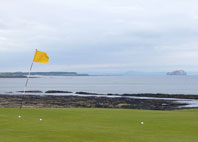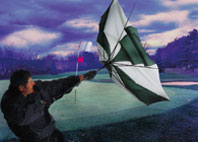Golf in a Gale
A brief glance at the weather-beaten faces of the Walker Cup players last weekend, combined with the news that European Tour Qualifying School was delayed due to high winds, is evidence enough that the wind plays a major role in autumnal golf in the British Isles.
Playing in a strong breeze isn’t easy at the best of times, but you can make life a lot easier by simply making the right choices. The old adage ‘swing slower in the wind’ makes sense, but better course management when the breeze is up is likely to have an even more positive effect on your scorecard than simply altering your style of swing.
We all know that hitting into or straight down the wind will affect how far our ball travels through the air, but how much consideration do you give to the distance and direction the ball will roll after landing? And where will it spin to?  For example, how many times have you hit a full wedge into a strong breeze that lands in the middle of the green, only to spin off the front? Or been perplexed when playing down wind and your deliberate ‘under clubbing’ hasn’t stopped the ball from rolling, and rolling, and rolling over the back? Granted, it’s a skill to play shots with that much control, but if you have designs on playing to a back flag position into the wind, you’ll probably need to manufacture a lower running shot with a longer iron, rather than trying to fly your stock shot all the way to the far edge of the green.
For example, how many times have you hit a full wedge into a strong breeze that lands in the middle of the green, only to spin off the front? Or been perplexed when playing down wind and your deliberate ‘under clubbing’ hasn’t stopped the ball from rolling, and rolling, and rolling over the back? Granted, it’s a skill to play shots with that much control, but if you have designs on playing to a back flag position into the wind, you’ll probably need to manufacture a lower running shot with a longer iron, rather than trying to fly your stock shot all the way to the far edge of the green.
The same applies to a cross wind. Imagine a right-to-left wind with the hole on the left hand side of the green. A golf ball coming in to land will inevitably be travelling in a direction towards the left, meaning that the roll and bounce of the ball will generally travel in this direction too. Therefore, you can allow for this roll and bounce of the ball to take your shot closer to the target. Why is this important? Well, when aiming for the safer ‘fat half’ of the green, it means that you need to consider where you want the ball to land, as well as where you want it to finish. For instance, a well struck five iron that uses a strong right-to-left wind is going to finish a good number of yards further forward and to the left of where it lands. Equally, the same shot in to a left-to-right wind will finish a similar distance to the right of where it lands.
One other major consideration with the wind is whether to use it as your friend or fight against it. Using the breeze generally means hitting a straight shot, and letting nature naturally influence the flight of the ball. By hitting against it, I mean trying to hit a left-to-right fade (for a right hander) that holds against a wind coming off the right, and vice versa.  It largely comes down to personal preference, but there are instances when you may not have much choice. Personally, I tend to let the wind do the work for me, but I’ll concede that there are times when I’ll need to fight it. Imagine a flag tucked away on the right side of the green, with a strong right-to-left wind. It’s quite possible that even with a perfectly struck shot that allows for the wind you won’t be able to hold the green, let alone get near the flag. If you can manufacture a fade in this instance, it can be the difference between holding the left side of the green, and not doing so!
It largely comes down to personal preference, but there are instances when you may not have much choice. Personally, I tend to let the wind do the work for me, but I’ll concede that there are times when I’ll need to fight it. Imagine a flag tucked away on the right side of the green, with a strong right-to-left wind. It’s quite possible that even with a perfectly struck shot that allows for the wind you won’t be able to hold the green, let alone get near the flag. If you can manufacture a fade in this instance, it can be the difference between holding the left side of the green, and not doing so!
Obviously these are fairly strong winds we’re talking about, but much of the country will see these conditions over coming weeks, so it may well be worth a thought. The wind is one of golf’s great challenges and levellers. For me, it provides the most fun conditions to play golf in, and when used as your friend, playing in the wind can be the most rewarding golf of all. The key is to think about how it will affect the flight of your golf ball and subsequently how the ball will respond when it lands.